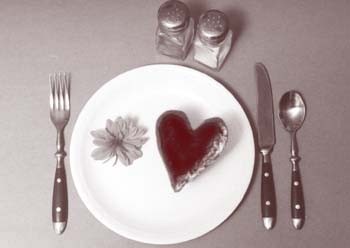Soul Food
Feeding your heart out
By Marina Wolf
EVERYONE KNOWS about “emotional eating”–that is, eating for any reason other than hunger. Personally, I’m more interested in the underresearched phenomenon of emotional feeding: feeding people for any reason other than the fact that it’s mealtime. The question I have is, is it something I can change, or do I just have to live with it?
I just wouldn’t mind the urge if it wasn’t so intense. How shall I put it? Next to me, the heroine in Like Water for Chocolate looks like a bored fry cook at a truck stop. Giving a dinner party, even for my closest friends, is like ripping my heart out and serving it up on a platter with a nice parsley pesto. I might as well rip my heart out, because it always stops when my guests take their first bite. I hover and press for reactions, but usually I don’t even need a verbal response. To a skilled and dedicated emotional feeder such as myself, their faces are a dead giveaway, rippling with subtle shifts and tics that mark the difference between ecstasy and mere politeness.
The world is full of other folks with this, well, not disorder, exactly, more of a penchant for really feeding people, body and soul. We’re the ones who came up with the post-funeral procession of casseroles. We’re the ones who don’t throw potluck parties; we want to cook everything ourselves. We bury our feeding impulses in gentle nagging at the dinner table–“Eat, eat, there’s plenty more where that came from”–or extravagant holiday packages of homemade banana bread.
Chefs are lucky. They get paid to obsess about what other people are putting in their mouths. They’re striving for a total dining experience, and they don’t necessarily mean finger bowls and gentle background music. They aim for utter rapture, a digestive trance. They don’t know you, but they want your bliss. In some circles this would be considered a pathetic desire for the approval of others, but I’d prefer to think it reflects a generous and giving spirit (better that than seeing a therapist for codependence issues).
Anyway, if I did ever go to a therapist for emotional feeding, we’d have to go back a long way back to get to the root. At age 5, I was already stripping the yard clean in search of ever-more exotic dishes for my beloved dolls–dandelion pie with a delicate mud sauce, tree-bark stew (that I got soundly spanked for my harvesting practices did not deter me from further experimentation). As I grew up, I found more socially acceptable outlets for my feeding frenzies, such as the occasional preteen slumber parties, which were the focus of months of menu planning.
I WASN’T REALLY aware of what I was doing until I threw my first dinner party, at the tender age of 15. I made lasagna, the most luxurious main course I could think of. For a teenager with Dairy Queen wages and cooking skills, it was positively extravagant, and tricky, too, full of things that hadn’t really hit the mainstream yet, like ricotta cheese and homemade tomato sauce. The ribbons of pasta stuck together, and the oregano in the sauce seemed way too strong. But when I pulled the bubbly casserole pan out of the oven and set it in front of my friends, it had become something beyond the sum of its ingredients ($36.43).
My desire to love and be loved rose off of the lasagna in great pungent clouds. When my guests took their first bite and groaned, I knew they could taste my affection, and they ate it up.
Every relationship is two-way, of course, and every feeder needs a devoted eater who values the display of love and respect even as he or she works it to pieces and wipes bread in the sauce. In college my best friend turned out to be my best and most reliable symbiont. She ate everything I made. She particularly loved my lentil stew, no matter how often I brought it to potlucks, and when I made borscht from a Russian cookbook she gave me one Christmas, she talked about it for months afterward. We lived either together or near enough not to matter, so even our grocery shopping had a certain synergistic blissed-out feel to it: she knew that I would feed her, and I knew that she would eat my food and love me.
I mean, it.
Obviously I’m not really trying to get away from this feeding habit. If I was, I wouldn’t have fallen in love with someone who used to run a restaurant. It’s a perfect match. She can barely stand being in the kitchen, and any size of can larger than 28 ounces makes her nervous, but she loves my food. One of the ways I know the relationship is going strong is that I will still spend hours obsessively charting meals for just the two of us.
Hey, if I’m going to wear my heart on a platter, I want it served just right.
From the September 9-15, 1999 issue of the Sonoma County Independent.
© Metro Publishing Inc.











